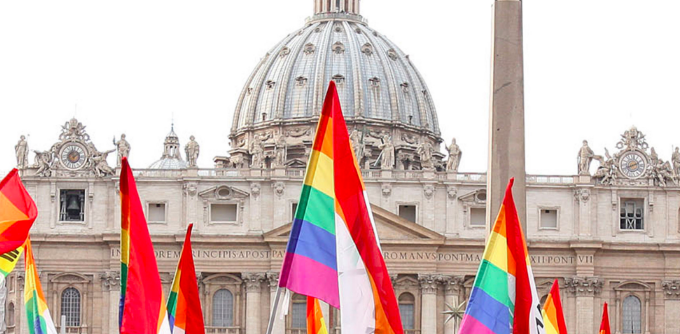Making Change

In addition to Ellie Harty’s post in The Table about our Philadelphia demonstrations, most of the articles I am reading this week raise the question: how do things change in our church?
Much of this discussion focuses on Juan Carlos Cruz’s report of his meetings with Pope Francis. The crucial quote is: “Look, Juan Carlos, the pope loves you this way. God made you like this and he loves you.” The Vatican does not comment on private conversations, a spokesman issued in response, so for now, Cruz’s summary stands.
Marianne Duddy-Burke wonders for how long, but then suggests the way forward, theologically:
The pope saying that God created an individual as gay goes far beyond a pastoral statement of welcome, as many are characterizing the conversation. It sets a new foundation for Catholic teaching about sexual orientation that is very different than what has been traditionally stated. If God creates us with our sexual orientation — and gender identity* — as part of who we are, the doctrine that LGBTQI people are not part of God’s plan for humanity cannot stand. We can no longer be considered “objectively disordered,” and the church’s entire theology of human identity and relationships will need to be reconsidered.
If the church acknowledges that God creates diversity in sexual orientation and gender identity, then it can no longer hold that gender complementarity (specific, divinely ordained roles for males and females) and heterosexual marriage, oriented toward producing and raising children, are the only possibilities for the full realization of human potential. It must dismantle all teachings based in heteronormativity, and develop teachings based on the incredible variety of human identities as a reflection of God’s infinite creativity. All are blessed, and all are sacred.
Duddy-Burke takes the question way beyond gay identity to the theology of complementarity, which so disadvantages women in the teachings of the church. Her move is a testament to the feminist theology of the last 50 years, at least. Probably Francis would not understand this logical leap; his frequent calls for a “theology of women” reveals that he is unfamiliar with this important body of work. It exists; it informs our whole cause, and is complementary to the theology around LGBTQI issues as well.

Both Cruz and Duddy-Burke emphasize the power of personal conversations for breaking barriers and creating change. What about demonstrations? John Gehring analyzes what he calls “disobedience” in another important article this week. While he starts out looking at how a few American bishops and Catholic activists resist punitive immigration restrictions, he goes on to provide a history of religiously-inspired political action in the 20th century. Most intriguing to me is a summary of the theology of civil disobedience based on Thomas Aquinas, as articulated by San Diego Bishop Robert McElroy, who
distinguishes between two types of civil disobedience. The first category involves breaking a law that is clearly unjust and requires a citizen to commit an immoral act. In this case, the law is broken precisely to avoid moral wrongdoing. The second category of civil disobedience occurs when a citizen disobeys a morally neutral law in order to call attention to a moral wrong which is not specifically related to the law being broken.
Let me be clear; Aquinas and McElroy are writing about disobeying laws in the secular realm. But Gehring’s summary fascinates me when I use McElroy’s distinction to understand our witnesses. Certainly Roman Catholic Womenpriests and others have acted under the first category of disobedience by breaking the unjust church law and ordaining women. The moral wrong done to women who have vocations is avoided.
The public demonstrations for women’s ordination, from Pink Smoke in Rome to Holy Thursday in Philadelphia and so many others, have broken civil laws about assembly and risked arrest – with some actual arrests in Rome – in order to make a point, a symbolic point, about the injustice of the church’s current position. The laws these demonstrations break are morally neutral, taking no position on women’s ordination. But breaking these laws is used to promote change in church law, largely with the cooperation of the media, an aspect of public resistance that Gehring does not emphasize.
Rather, he really wants to promote more activism – among bishops, clergy, laity, millennials, and religious sisters (who do show up) – an activism that he wants to see springing from deep roots in Catholic culture, not only from outrage at current policies. He goads bishops to risk arrest in protests over immigration policy and quotes David DeCosse about going beyond symbolic actions to effective politics.
So, shall we run for Cardinal? That’s where the analogy between church and civil disobedience breaks down. But wait – the proliferation of intentional Eucharistic communities led by women, prayer circles with youthful leadership, and activist social justice groups, most unaffiliated with the institution, suggests that a new church is building. It’s not disobedient. Its members are personally connected with each other. It has a real theology. It’s making change.

3 Responses
“The moral wrong done to women who have vocations is avoided.” Agree, but there is more: the wrong is done to the entire body of Christ, not only to women.
Yes, Luis, when I read this over I wished I had said it your way.
The difference between this world going towards “1000” years of Peace or more wars
if we no long support sexism, racism, inequality!
No more money for sexism, racism, negative inequalities!
Blessings for all you do to share this message.
Want or need more info email me:
equality4peace.com